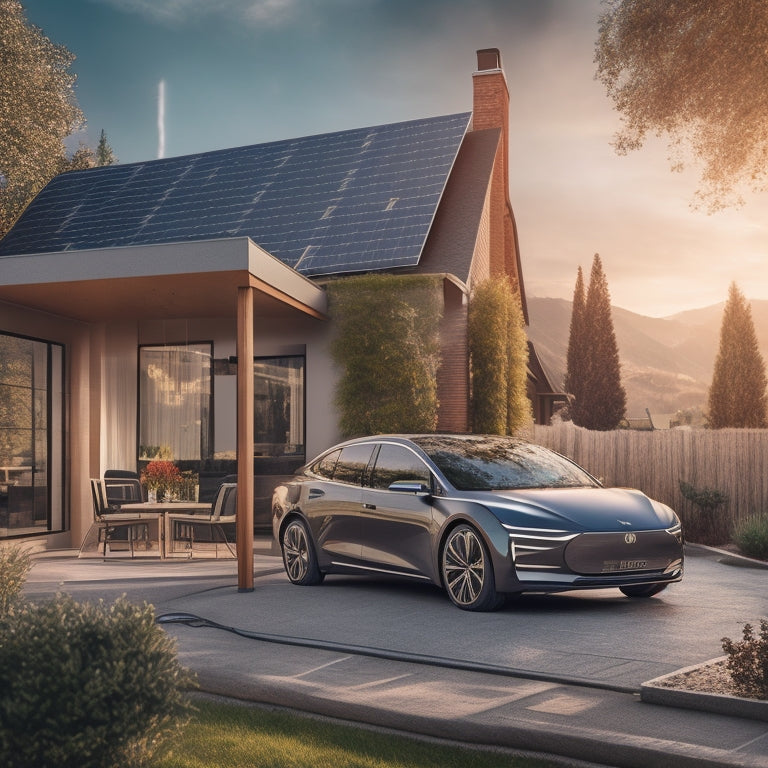
Optimizing EV Charging With Solar Panel Arrays
Share
When optimizing EV charging with solar panel arrays, you'll want to examine energy audits, load profiles, and peak demand periods to determine the ideal array size and energy storage requirements. Balance energy distribution to reduce peak demand, and assess land use for the array. Adjust panel orientation to capture maximum sunlight, and select high-efficiency inverters to minimize energy losses. Implement smart grid systems and load management strategies to balance energy supply and demand. As you navigate the intricacies of EV charging and solar panel integration, you'll discover even more opportunities to refine your approach and maximize energy independence.
Key Takeaways
• Conduct energy audits to identify peak demand periods and optimize energy distribution to minimize strain on the grid.
• Design solar panel arrays considering land use, available space, and aesthetics to maximize energy production and meet EV charging needs.
• Optimize energy generation by fine-tuning panel orientation, adjusting panel angle, and selecting high-efficiency inverters to minimize energy losses.
• Implement peak shaving strategies, energy forecasting, and smart grid systems to balance energy supply and demand, and manage peak demand.
• Monitor key performance indicators, such as charging speed, energy efficiency, and system reliability, to guarantee peak performance and identify areas for improvement.
Assessing Energy Demands and Load
To accurately plan and optimize EV charging infrastructure, you must first evaluate the total energy demand and load requirements of your charging station.
This involves conducting a thorough energy audit to identify the peak demand periods, average energy consumption, and load profiles.
Load profiling is a vital step in this process, as it helps you understand the charging patterns and habits of your users.
By analyzing the load profiles, you can identify opportunities to optimize energy distribution, reduce peak demand, and minimize strain on the grid.
Energy auditing is another essential step in evaluating energy demands and load requirements.
It involves a detailed analysis of your charging station's energy consumption, including the type and number of EVs, charging speeds, and usage patterns.
This information helps you to determine the ideal solar panel array size, configuration, and energy storage requirements.
Selecting Optimal Panel Orientation
With your energy demand profile in hand, you can now focus on maximizing the energy output of your solar panel array by fine-tuning panel orientation.
The goal is to adjust the panel angle to capture the most sunlight throughout the year. To achieve this, you'll need to take into account the seasonal variance in sunlight intensity and direction.
During the summer months, the sun is higher in the sky, while in the winter, it's lower. By tilting your panels at a favorable angle, you can capitalize on these changes.
A general rule of thumb is to set the panel angle to your location's latitude, adjusted for the time of year. For example, if you're in a region with a latitude of 35°, you'd set your panels to 35° during the summer and 55° during the winter.
This adjustment will guarantee you're harnessing the maximum amount of energy from the sun. By doing so, you'll be able to charge your EV efficiently and sustainably.
Determining Array Size and Layout
You'll need to determine the ideal array size and layout for your solar panel system, as it directly impacts the amount of energy generated to charge your EV.
A well-designed array won't only maximize energy production but also consider array aesthetics, ensuring a visually appealing installation that complements your property.
To get started, assess your land use and available space for the array. Consider the size and shape of your roof or available land, taking into account any obstacles or shading issues.
Next, calculate your energy requirements based on your EV's charging needs and your desired level of energy independence. This will help you determine the ideal array size and configuration.
A larger array may provide more energy, but it may also increase costs and impact array aesthetics. By balancing these factors, you can design an efficient and visually appealing array that meets your EV charging needs while minimizing its footprint on your land.
Balancing Energy Storage and Generation
As you work to optimize EV charging, you'll need to carefully balance energy storage and generation to facilitate a smooth and efficient flow of power.
This means reconciling energy supply and demand, optimizing storage capacity, and implementing peak shaving strategies to manage energy usage.
Energy Supply and Demand
To guarantee a seamless EV charging experience, you must balance energy supply and demand by synchronizing energy storage and generation to mitigate potential power grid overload. As the world shifts towards sustainable energy sources, it's vital to optimize energy supply and demand to facilitate a smooth shift.
To achieve this balance, you can leverage advanced technologies like energy forecasting, which enables you to predict energy demand and adjust your energy supply accordingly. This approach helps reduce strain on the grid and prevents overload.
Additionally, incorporating carbon pricing into your energy strategy can incentivize the use of renewable energy sources, further reducing your carbon footprint.
Other key considerations for balancing energy supply and demand include:
- Implementing smart grid systems that can dynamically adjust energy distribution
- Investing in energy storage solutions like batteries to stabilize the grid
- Encouraging time-of-use pricing to shift energy consumption to off-peak hours
- Developing advanced weather forecasting to optimize solar panel array output
Storage Capacity Optimization
By strategically allocating storage capacity, you can harmonize energy storage and generation, achieving a stable and efficient energy supply that meets fluctuating demand.
This delicate balance is vital in synchronizing EV charging with solar panel arrays. When you maximize storage capacity, you can minimize energy waste and reduce the strain on your solar panel array.
This, in turn, helps prolong the life of your batteries by reducing the number of charge cycles. As you know, excessive charge cycles can negatively impact battery health, leading to reduced capacity and overall system efficiency.
To achieve ideal storage capacity, you'll need to carefully assess your energy generation and consumption patterns.
By analyzing your energy usage, you can identify periods of high demand and adjust your storage capacity accordingly. This may involve installing additional battery banks or optimizing your charging schedules to minimize peak demand.
Peak Shaving Strategies
You can implement peak shaving strategies to balance energy storage and generation, ensuring that your EV charging infrastructure operates within a stable and efficient range. By doing so, you can mitigate the strain on the grid and reduce your energy costs.
To achieve peak shaving, consider the following strategies:
-
Time of Use (TOU) Pricing: Adjust your charging schedules according to TOU pricing structures to take advantage of lower rates during off-peak hours.
-
Load Forecasting: Utilize advanced load forecasting algorithms to predict energy demand and optimize your charging schedules accordingly.
-
Energy Storage Optimization: Optimize your energy storage capacity to absorb excess energy generated by your solar panel array during the day and release it during peak hours.
- Smart Charging: Implement smart charging systems that can dynamically adjust charging rates based on real-time energy availability and demand.
Ensuring Efficient Power Conversion
Efficient power conversion is crucial in electric vehicle (EV) charging, as it directly affects the overall energy efficiency and charging speed, with even slight improvements translating to significant reductions in energy losses and heat generation.
When you're optimizing EV charging with solar panel arrays, you need to guarantee that the power conversion process is as efficient as possible. This means focusing on DC optimization, which involves maximizing the energy output of your solar panels.
To achieve this, you'll need to select high-efficiency inverters that can convert DC power from the solar panels to AC power for your EV charger. Inverter efficiency is critical, as it directly impacts the overall energy efficiency of your charging system.
Look for inverters with high conversion efficiencies, typically above 98%, to minimize energy losses. By optimizing power conversion, you can reduce energy losses, heat generation, and even lower your operating costs. By doing so, you'll be able to charge your EV more efficiently, reliably, and sustainably.
Integrating With Existing Infrastructure
As you integrate electric vehicle (EV) charging stations with existing infrastructure, you'll need to think about the existing grid connection and its capacity to handle increased energy demand.
You'll need to verify that the EV charging system can harmonize energy flow with the grid, avoiding peak-hour strain and maintaining a stable supply.
Existing Grid Connection
Integrating electric vehicle (EV) charging infrastructure with existing grid connections requires careful planning to avoid overloading the electrical distribution system. As you venture into this integration, careful thought must be given to the existing grid's capacity to handle the increased demand from EV charging.
To achieve a seamless integration, ponder the following key factors:
Grid Modernization: Upgrade the grid infrastructure to accommodate the increased power demand from EV charging. This includes installing advanced technologies like smart meters and grid management systems.
Utility Partnerships: Collaborate with utility companies to verify that the grid can handle the additional load and to develop strategies for managing peak demand.
Load Management: Implement load management strategies, such as time-of-use pricing and demand response programs, to balance the grid's load and prevent overloading.
Infrastructure Upgrades: Upgrade the electrical infrastructure, including transformers and distribution lines, to handle the increased power demand.
Harmonizing Energy Flow
You'll need to synchronize your EV charging infrastructure with the existing energy flow to prevent disruptions and guarantee a seamless shift.
This harmonization is vital to facilitate that the energy waves generated by your solar panel array don't clash with the existing grid's frequency. Imagine your EV charging system as a new instrument joining an orchestra - it must be tuned to the same rhythm as the existing energy flow to create a harmonious symphony.
To achieve this, you'll need to integrate your EV charging infrastructure with smart grids that can dynamically manage energy distribution.
These advanced grids can adjust energy flow in real-time, verifying that your solar-powered EV charging system complements the existing energy infrastructure. By doing so, you'll minimize the risk of power fluctuations and guarantee a stable energy supply.
In addition, smart grids can optimize energy distribution, reducing energy waste and maximizing the efficiency of your EV charging system.
Monitoring and Maintaining Performance
To guarantee peak performance, you must regularly monitor your EV charging system's key performance indicators (KPIs), such as charging speed, energy efficiency, and system reliability. This confirms that your solar panel array is generating the maximum amount of energy possible and that your EV charging system is operating at peak levels.
To achieve this, you'll need to leverage data analytics and performance benchmarking to track your system's performance over time. This will help you identify areas for improvement and make data-driven decisions to fine-tune your system.
Some key metrics to monitor include:
-
Energy yield: The total amount of energy generated by your solar panel array
-
Charging efficiency: The percentage of energy transferred from the grid to your EV's battery
-
System uptime: The percentage of time your EV charging system is available and operational
- Error rates: The frequency of errors or faults occurring within the system
Future-Proofing for Scalability
As you expand your EV charging infrastructure, designing it with scalability in mind is essential to accommodate growing demand and future technological advancements.
This requires a forward-thinking approach that considers potential upgrades, expansions, and integrations with emerging technologies.
A modular design is key to achieving this flexibility, allowing you to easily add or replace components as needed.
This approach enables you to incrementally increase capacity, adapt to changing energy storage needs, and incorporate new charging technologies as they emerge.
To guarantee grid resilience, your scalable design should also prioritize energy efficiency, load management, and peak demand reduction.
By incorporating energy storage systems, such as batteries, you can optimize energy distribution, reduce strain on the grid, and provide a buffer against power outages.
As you future-proof your EV charging infrastructure, you'll be well-equipped to handle increasing demand, integrate with emerging technologies, and maintain a reliable, efficient, and resilient energy supply.
Frequently Asked Questions
Can I Use a Single Solar Panel Array for Multiple EV Charging Stations?
You can share a single solar panel array among multiple EV charging stations, but you'll need to implement load balancing and energy allocation strategies to guarantee efficient distribution of power and prevent overloading.
How Do I Ensure My Solar Panel Array Is Bird-Poop Resistant?
"Like a bird dodging a predator, you'll want to shield your solar panel array from unwanted droppings. Consider applying bird-deterrent panel coatings or investing in a bird-repellent system to keep your setup poop-free and efficient."
Are There Any EV Charging Stations Specifically Designed for Solar Power?
You'll find EV charging stations specifically designed for solar power, like those integrated with Solar Roofs, which efficiently harness energy and store it in advanced Energy Storage systems, ensuring a seamless charging experience.
Can I Use My Existing Electrical Infrastructure for EV Charging?
You'll need to assess your electrical infrastructure's capacity before installing an EV charger, considering circuit upgrades and load calculations to guarantee your system can handle the added power demand without overheating or tripping.
Do I Need a Separate Inverter for Each EV Charging Station?
'Many hands make light work,' and in this case, one inverter can do the heavy lifting for multiple EV charging stations, but you'll need to guarantee Grid Tie and Power Conditioning harmony to achieve Electrical Harmony, so it's possible, but not always necessary.
Related Posts
-

Why Solar HVAC Filters Revolutionize Home Energy Efficiency
By adopting solar HVAC filters, you're shifting your home's energy reliance from fossil fuels to clean, renewable sou...
-

What Tax Deductions Apply to Sustainable Building Materials?
You can claim various tax deductions for sustainable building materials, thanks to over 40 federal tax incentives sup...
-

10 Grid-Tied Wind Power Systems for Modern Homes
You're looking for a grid-tied wind power system to utilize wind energy for your modern home. Here are ten options to...


